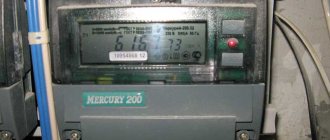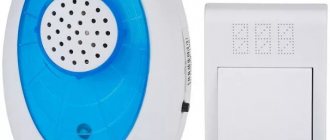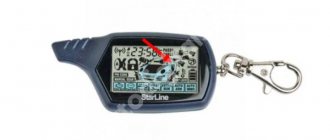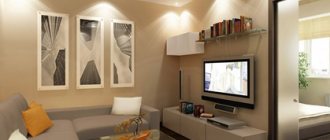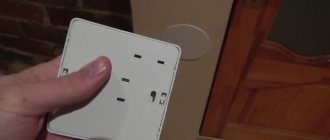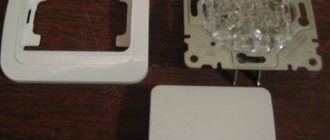What is a wireless switch for?
Remote systems that provide control of certain devices at a distance are becoming increasingly widespread. The wireless wall switch is no exception.
It was created to increase comfort, and for senior citizens and people with disabilities it is absolutely necessary.
Using such a device, you can easily control the lighting in your home, change the brightness, turn lamps on and off.
In addition, thanks to the special design, there is no need to damage the walls or make large holes for installation.
RGB controller
For newer light sources, such as LED strips, special controllers have been developed that allow you to adjust not only the brightness of the lighting, but also select the range of the glow.
This is very useful for emotional “relaxation” or highlighting a certain mood of the composition. This type of remote control of the LED strip allows you to give the interior a unique twist each time, as can be seen in the photo below:
This type of lighting can be created by any handyman; all components can be purchased at your local radio or electrical store.
There are also interesting new items, so to speak toys, lighting control via WIFI and a special application for a smartphone. You can learn more about remote control of light via a Wifi remote control or a phone application by watching this video:
How to control light via phone
Ready-made devices for controlling lighting in a house or apartment are good, but they are not always adequately priced, or are not exactly what is needed, and have low functionality. Keeping up with the times, home craftsmen should pay attention to microcontrollers, which we will discuss below.
Scope of application
Traditional switches are gradually becoming a thing of the past due to inconvenience of use, complexity of connection and installation, as well as a small resource. Wireless analogues have better qualities.
They have a stylish appearance and install within a few minutes.
The use of such products is relevant in the following cases:
- When moving an old switch, when pieces of furniture interfere with its installation. The new device can be mounted anywhere in the room - on a wall, mirror, cabinet or other element of the room.
- To eliminate electrical errors. When installing wiring, mistakes are often made that affect the comfort of living in an apartment or house. In such cases, it is not necessary to make a strobe or plan expensive repairs - you can install a wireless switch (with or without a remote control).
- When there is a shortage of space. The classic option is that it is difficult to install the switch on a cabinet or other piece of furniture due to the complexity of the mounting. Wireless analogues are overhead, and their installation is accessible even to beginners. In addition, during the installation process there is no need to lay the cable and worry about its disguise. And the radio switch can be placed anywhere, be it a coffee table, bar counter, bedside table or other piece of furniture.
- In wooden houses. The advantage of buildings made using wooden materials is undeniable. They are distinguished by their durability, ability to retain heat, and also low price. But when installing wiring, problems arise due to increased safety requirements. The best option is to install open wiring, but it spoils the appearance of the interior and is susceptible to mechanical damage (including from rodents). Making hidden wiring in a wooden house is quite a problem. The best solution is to install wireless light switches, which simplify the process of installing hidden wiring and save money.
- To control lighting from multiple locations. There are situations when turning on the light needs to be done from 2-3 parts of the room. To avoid running wires to each switch, it is better to use wireless devices. With their help, lighting control is simplified and installation time is reduced. If desired, you can install wireless switches with a remote control.
- If necessary, install additional switches. It happens that after completion of the repair work the chosen location is not satisfactory and the installation of an additional device to control the light is required. Installing a wireless switch solves the problem.
- To turn lights on/off over long distances. What to do in a situation where you need to turn the lamp on and off from another room or even from the street? Running a wire to install an additional switch is expensive and unsafe, but new technology allows you to avoid such problems. The peculiarity of radio switches is their large operating range - up to 350 m (depending on the model). Control can be done using a simple remote control, which for convenience is made in the form of a key fob.
- In order to preserve the design of the room. If installing a switch in a recess is not possible, you have to install overhead types of products that spoil the appearance of the room and do not look very solid. The solution to the problem is to install a wireless device that is thin and fits perfectly into the interior.
- As an alternative to conventional devices. During the next renovation of an apartment or house, you want to introduce some innovations into the design and make life more comfortable. One way is to install a wireless remote switch. Such products will cost more, but they are easy to install, have a solid appearance and provide ease of lighting control.
Varieties
Wireless switches are not very diverse, but there is still a certain selection.
They are classified according to three main characteristics:
- By type of control;
- If possible, regulate the level of illumination;
- By the number of lighting devices they control.
Taking into account the classification mentioned above, the following types of wireless switches can be distinguished:
- With a delay function to ensure the lamp stays on for a certain amount of time. This option allows, for example, to walk to the bed while the light is on, after which the room is plunged into darkness.
- With the ability to configure multiple channels. In this case, it is possible to turn on several products simultaneously.
- Sensory. To turn the lighting on/off, just touch the panel.
- Wireless (with the ability to control over a Wi-Fi network) or radio controlled.
Design and principle of operation of the main elements of the device
The wireless switch consists of the following elements:
- The receiver is a special radio relay that is controlled by a remote control, using a phone with access to Wi-Fi, or directly from a switch. After receiving the signal, the relay closes or opens the contacts. The product is mounted as close as possible to the light source or inside it (if the appropriate dimensions are available).
If we are talking about a spotlight, installation is carried out in a junction box or in the cavity between the main ceiling and the tension fabric. - Transmitter (switch). This device includes a small generator that generates electricity when you press a remote control button, touch a switch, or send a signal from your phone (when controlled via Wi-Fi). The electrical impulse is converted into a radio signal, which is picked up by the receiver. The transmitter can be installed directly into the wall. In this case, there is no need to connect wires to it, because power is supplied from the built-in elements. Thanks to this feature, you can save time on installation and not open the walls. In this way, a transition switch is made that allows you to control the lighting from different points and not have to look for the remote control.
Light control equipment
To provide remote lighting activation, the following equipment can be used:
- wall type controllers;
- remote control lighting switches;
- personal computer (PC);
- mobile device (phone or smartphone).
Now let's look at the capabilities of each of these devices.
Wall type controller
Externally, the wall controller looks like a regular switch. It is also used to transmit a signal to turn the light on or off. You can attach it to the wall if you have a few construction screws in stock. This device is powered by a battery.
Recent Entries
Lilac perennials that are beautiful, compact and do not crowd out other plants Why when buying seedlings you should not take the sellers’ word for it and how to determine the age of the plant using 3 signs Tomato seedlings have turned purple or whitish: why the color has changed and how to save the plants
Light switches and their types
Remote lighting switches are conventionally divided into two groups - infrared and radio-controlled:
- Infrared. Today we are so accustomed to remote controls with which we can turn on the TV or change its channels that we become absolutely helpless if this “smart” device suddenly gets lost. Improvements in TV control gave rise to many other devices, commands for which were also given from remote controls. Further developments contributed to the emergence of electrical devices controlled by infrared rays. The disadvantage of infrared control panels is their limited coverage area: only within visibility. Even 12 meters can become an insurmountable distance for them.
- Radio controlled. A light switch with a radio wave remote control performs its functions perfectly even outside the direct line of sight. It is also important that the radio airwaves are not clogged when operating such remote controls. To meet the needs of a garden plot, a transmitter with a power of 10 milliwatts, operating at a frequency of 433 or 868 MHz, is sufficient. The range of action of such a device is 100 meters. However, the presence of natural obstacles can reduce the reception area of its signal. But with the help of a repeater, this problem can be solved.
Remote site lighting switches can be radio-controlled or infrared. Their main difference is the coverage of the territory during signal transmission
Here is an example of a simple Chinese device:
You can also remake an existing remote control in conjunction with a special controller:
PC and light control
You can control the lighting of your home and site using a personal computer. Special software has been developed for it. If the owner of the site spends a lot of time working at the computer, then he does not need to use a remote control to control the light - just use his own PC.
The computer is convenient when remote control is needed. You can, for example, turn off a forgotten light or, conversely, turn it on to create the effect of the presence of the owners of the house.
Both a personal computer and a regular cell phone or smartphone can be used as equipment for remote lighting control with the appropriate software
Control via mobile devices
In this case, the smartphone performs the same function as a computer. The corresponding software applications can also be loaded into it. Having an ordinary cell phone, you can not only turn the light on and off, but also adjust its intensity. This is done using encrypted SMS messages.
Advantages and disadvantages of wireless switches
Despite their ease of use, wireless load switches (in our case, lighting) have not only advantages, but also disadvantages. But more about everything.
Pros:
- Ease of installation. For installation and connection, you do not need to drill into walls or lay a separate “branch” of electrical wiring.
- Possibility to control several light sources at once from the remote control or via a smartphone.
- Large range of action. The control signal in an open area can reach the receiver at a distance of up to 30 meters. In this case, walls or pieces of furniture are not an obstacle.
- Safety for adults and children. Even accidental damage to the structure does not pose a health risk. The operating current in wireless remote switches is minimal and not hazardous to health.
Minuses:
- The cost of such products is higher than classic “wired” switches. Adherents of economy and conservatives prefer familiar products.
- Inability to control due to low battery in the remote control or inability to control due to weak Wi-Fi connection.
Laser based remote light switch
This simple remote switch circuit is based on the NE555 timer. A laser pointer is used as a control element. This scheme was tested at a distance of 50 meters and showed good results. By and large, the range depends on the power and quality of the laser itself. Electrical diagram of the remote switch:
When the laser beam is pointed at the photoresistor U1, the load is turned on through an electromagnetic relay, and when the laser beam is focused on the photoresistor U2, the load is turned off.
Characteristics you should pay attention to when choosing
When purchasing a wireless remote switch, you should pay attention to the following parameters:
- The type of light bulbs the device controls;
- Material, color and appearance of the case;
- Operating voltage;
- Number of channels;
- Radius of action;
- Maximum load;
- Dimensions;
- Rated current;
- Equipment.
It is also worth paying attention to the following criteria:
- Operating frequency range;
- Signal transmission method;
- Availability of encoding;
- Transmitter power type;
- Estimated battery replacement time;
- Fastening method;
- Operating temperature range;
- Price.
What does the market offer?
A wide range of wireless remote switches allows you to choose a product based on price, characteristics and appearance.
Below we consider just a few models that the market offers:
- Fenon TM-75 is a remote-controlled switch made of plastic and designed for a voltage of 220 V. The features of the device include the presence of two channels, a 30-meter range, the presence of a remote control and a delay switch function.
A group of lighting fixtures can be connected to each channel and controlled. The Fenon TM-75 wireless switch can be used with chandeliers, spotlights, LED and track lights, as well as other devices operating on 220 Volts. - Inted 220V is a wireless radio switch designed for wall mounting. It has one key and is installed in conjunction with the receiving unit. The operating voltage of the product is 220 Volts, and the range is 10-50 meters. The wireless light switch is attached using self-tapping screws or double-sided tape. The body is made of plastic.
- INTED-1-CH is a light switch with remote control. With this model you can control light sources remotely. The power of the lamps can be up to 900 W, and the operating voltage of the product is 220 V. Using a radio switch, you can control the equipment, turn on and off the lights or alarms. The product is based on a receiver and transmitter. The latter has the form of a key fob, which is small in size and transmits a signal over a distance of up to 100 m. The product body is not protected from moisture, so additional protection must be provided when installing outdoors.
- Wireless touch switch controlled via remote control. The product is mounted on the wall, has small dimensions and is made of tempered glass and PVC. The operating voltage is from 110 to 220V, and the rated power is up to 300 W. The package includes a switch, remote control and bolts for attaching the accessory. The average life cycle is 1000 clicks.
- Inted 220V 2 Receiver - Wireless Light Switch for Wall Mounting. Control is carried out using two keys. The body is made of plastic. The operating voltage is 220 V. The number of independent channels is 2.
- BAS-IP SH-74 is a wireless radio switch with two independent channels. Control is carried out using a mobile phone on the Android operating system. To work, you must install the BAS application. The SH-74 model is used to control incandescent lamps with a power of up to 500 W, as well as fluorescent light bulbs (power limit - 200 W).
- Feron TM72 is a wireless switch that controls lighting at a distance of up to 30 meters. The light sources are combined into a receiving unit, and switching on and off is done using the remote control. The TM72 model has two channels, each of which can be connected to a specific group of devices. The product has a large power reserve per channel (up to 1 kW), which allows you to connect different types of light sources. The big advantage of the model is the presence of a delay ranging from 10 to 60 seconds.
- Wireless 3-channel switch 220V Smartbuy is designed for connecting light sources into three channels with a power limit of up to 280 W. The rated supply voltage is 220 V. Control is carried out from the remote control, which has a range of 30 meters.
- Z-Wave CH-408 is a wall-type radio switch that allows you to program various scenarios for controlling lighting devices. If necessary, up to eight switches can be connected to it. Among the additional features, it is worth highlighting the management of Z-Wave devices (up to 80) and ease of configuration regardless of the main controller. The device is powered by two batteries, and when they are low, a corresponding signal is given. Firmware updates are performed via the Z-Wave network. The maximum distance to the controller should not exceed 75 meters. Protection class - IP-30.
- Feron TM-76 is a wireless light switch that is controlled remotely using a radio signal. The receiver connects to light sources, and the remote control controls the receiving unit at a distance of up to 30 meters. The Feron TM-76 model has three independent channels, each of which can be connected to its own group of lighting fixtures. In this case, control will be carried out separately, using the remote control. The maximum power reserve is up to 1 kW, which allows you to connect various types of lamps (including incandescent). The operating voltage is 220 V.
Remote light switch using remote control
This is a simple circuit for remotely turning on and off any electrical device using a regular remote control (RC).
2 in 1 soldering station with LCD display
Power: 800 W, temperature: 100...480 degrees, air flow...
More details
The range of the remote switch is about 10 meters. The sensor is a 3-pin IR receiver (TSOP 1738 or equivalent) operating at a frequency of 38 kHz. When IR radiation is detected, a log.0 signal appears at the output of the sensor, which in turn is amplified by transistor VT1.
From the output of transistor VT1, the amplified signal triggers the standby multivibrator on the NE555 timer. A pulse from the output (3) of the timer, with a duration of 1 second, switches the JK flip-flop, whose output (1) controls the electromagnetic relay through a transistor (VT2). With each new signal from the NE555, the output of the JK flip-flop will change to the opposite state.
LED HL1 is used to display the status of the output stage during operation of the device. The circuit is powered by a 7805 voltage regulator. Capacitor C2 and resistor R4 are designed to prevent false operation of the NE555 timer.


